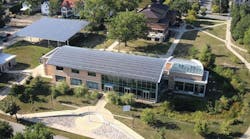A Paler Shade of Green
John H. Scofield’s analysis of the performance of the Adam Joseph Lewis Center for Environmental Studies at Oberlin College (“A Paler Shade of Green,” January 2013, http://bit.ly/Scofield_0113) was a breath of fresh air. It is rare among articles on “green” or LEED buildings or those purporting to be “zero net energy” not to find long paragraphs of optimistic but unsubstantiated blather about how “environmental” the construction is or how the magical ground-water “geothermal” heat pumps will heat and cool the building for practically nothing. But few articles are written to provide a candid assessment of the building’s actual performance and failings.
The Scofield article points out the hard truth that it is very difficult to construct a high-performance commercial building. We can infer that design firms too often turn out drawings for projects that do not come close to meeting vaunted design objectives or public-relations hype. Because few buildings are rigorously monitored after construction, wild claims of high performance are generally accepted at face value by the public. One suspects designers may feel no qualms about making grossly optimistic pronouncements knowing there will be nobody checking. In the worst cases of building design failure, a more likely explanation is that the designers took on work beyond their competence.
Candid post-occupancy articles such as Professor Scofield’s provide a painful but extremely valuable service to the engineering and architectural professions.
While the Scofield article is rich with insight on some of the reasons the building did not perform as well as advertised, more details on the building envelope would have been very welcome.
Carl Mezoff, PE, architect
Stamford, Conn.
Very instructive. One of the best high-performance-building case studies I have read. Neither the engineers nor Oberlin are to be blamed for their courage in funding, designing, and constructing such an advanced building. However, only the full disclosure of actual performance will lead the way to future improvement. Even though the building falls short of (its zero-energy goal), I assume it uses far less energy than a conventional “code” building.
Ron Wilkinson
Via the Internet
Letters on HPAC Engineering editorial content and issues affecting the HVACR industry are welcome. Please address them to Scott Arnold, executive editor, at [email protected].









